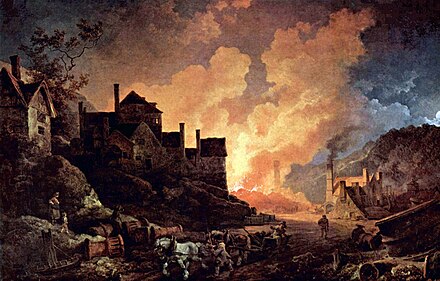Już 62 572 użytkowników uczy się języków obcych z Edustation.
Możesz zarejestrować się już dziś i odebrać bonus w postaci 10 monet.
Jeżeli chcesz się dowiedzieć więcej o naszym portalu - kliknij tutaj
Jeszcze nie teraz ZAREJESTRUJ SIĘlub
Zaloguj »Rewolucja przemysłowa (1)
Temat: Historia i kultura
Do some Exercises: Słuchaj i zapisuj Tworzenie zdań Ukryte słowa
The Industrial Revolution is the name historians have given to the period in history when there was a large and rapid change in the way things were made. This meant that instead of things being hand made in small workshops, they were made more cheaply in large quantities by machines in factories.
Many people began to move from an agricultural based life in the country to the towns where the factories offered more and better paid work.
Beginnings
The Industrial Revolution began in Great Britain in the middle of the 18th century. In particular, the County of Shropshire was important, for it had both minerals (e.g. iron ore) and transport on the River Severn. This led to the group of industries near the Ironbridge Gorge and the town of Coalbrookdale.
Coalbrookdale is a town in England where new ideas for industry were first tried out. Here it is seen at night in 1801. The fires are from the large scale making of iron.
The revolution spread to Europe and the Americas, especially the United States, by the early 19th century. As new inventions were being created, factories followed soon thereafter. England wanted to keep its industrialization a secret, so they prohibited anyone who had worked in a factory to leave the country. Meanwhile, Americans offered a significant reward to anyone who could build a cotton-spinning machine in the United States. Samuel Slater, who had been an apprentice in an English cotton factory, disguised himself and came to America. he reconstructed a cotton-spinning machine from memory. He then proceeded to build a factory of his own.
New ideas and inventions were also taken up and used in mining, the working of metals, and in the transportation of goods. Around the same time the Agricultural Revolution was also using new ideas in farming which left some farm workers without jobs. They added to the move to the industrial towns where they sought out [[[:0:]]] factories.
The most important new invention of the industrial revolution was the steam engine. The steam engine, invented by James Watt around 1776 was used to power the factories and pump out the deeper mines. It was also used in railway engines. The heat from burning coal became the main source of power.
Some historians see the period called the industrial revolution as finishing about 1820, but they agree this was only the start of change in the way we make things, which continues right up to the present time. Many refer to the period after 1820 as the "Second Industrial Revolution".
Historians still disagree on why the Industrial Revolution happened when it did, and why it happened in England first. It built on a new spirit of studying things through science. The 17th century was a period called the Enlightenment by historians during which people asked more questions about the way the world worked. England also was a politically stable country throughout the 1700s with no wars at home (although it had many abroad). England was also lucky that it had many of the raw materials needed to make and power the new machines close by within its borders. It also had an overseas empire that would buy the goods it made and provide it with a cheap source of other raw materials such as cotton and sugar. At the time of the industrial revolution slavery was practiced in many British Empire lands, this supplied a source for some of the money which could be spent on building the new industries. Also, England had much less land that could be farmed compared to other European countries.
Source: wikipedia.org






